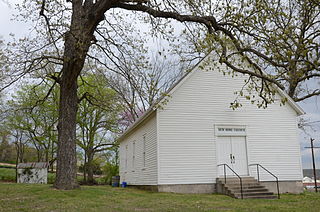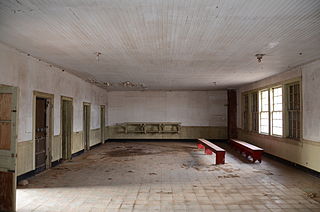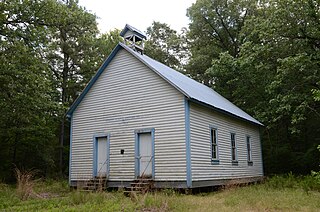
One-room schools were commonplace throughout rural portions of various countries, including Prussia, Norway, Sweden, the United States, Canada, Australia, New Zealand, the United Kingdom, Ireland, and Spain. In most rural and small town schools, all of the students met in a single room. There, a single teacher taught academic basics to several grade levels of elementary-age children. While in many areas one-room schools are no longer used, it is not uncommon for them to remain in developing nations and rural or remote areas. Examples include remote parts of the American West, the Falklands, and the Shetland Islands.

The Old Union School is a historic school building at 504 Old Union Road in Birdell, Arkansas. It is a single-story wood frame Plain Traditional structure, with a corrugated metal gable roof and a stone foundation. Built in 1913, it is one of the few older structures in Birdell, and the only one-room schoolhouse in southwestern Randolph County. The building was used as a school until 1941, and saw only occasional use for other community purposes until 1991, when it underwent a major restoration. It is now used as a community hall.

Powhatan Historic State Park is a 9.1-acre (3.7 ha) Arkansas state park in Lawrence County, Arkansas in the United States. The park contains the 1888 Powhatan courthouse which served as the home of county government from 1869-1968. Today the structure displays items of cultural and historical significance and hosts the park's Visitor Center. The park includes four additional historical buildings and the Arkansas History Commission's Northeast Arkansas Regional Archives. A tour of the historic structures is available. Powhatan served as an important stop for traffic on the Black River until the installation of the Kansas City-Memphis Railwayline two miles north in 1883 significantly decreased the need for river transportation.

The New Home School and Church is a historic community building on McKisic Creek Road south of Bella Vista, Arkansas. It is a modest single-story wood-frame structure, with a gable roof, which lacks ornamentation. Its main facade has a double-door entrance, and the side facades have three bays of windows. Built c. 1900, it is a well-preserved example of a multifunction vernacular community building, which was used as a school during the week and as a church on Sundays. The school function was discontinued after schools in the area were consolidated.

St. Barnabas Episcopal Church is a historic church at the junction of Tracy Lawrence Avenue and Bell Street in Foreman, Arkansas. It is a single-story wood-frame structure, designed by A. M. Hawkins and built in 1895 for a congregation whose origins lay in a mission established in the 1840s. The church has Gothic, Queen Anne and Stick style elements, including decorative cut shingles, stickwork in the gables, and Gothic lancet windows. In the 1950s an old one-room schoolhouse was attached to the church to serve as a parish hall; this was destroyed in a storm in 1993, replaced by new construction in 1996.

The Oak Grove Rosenwald School is a historic school building on Oak Grove Road in Oak Grove, a small settlement in southeastern Sevier County, Arkansas. It is a single-story wood-frame structure, built in 1926 with financial assistance from the Rosenwald Fund. It has two classrooms, and is based on a standard plan developed by Samuel Smith, an agent for the Rosenwald Fund, for this type of small community school. It was probably used for the education of local African Americans until the state's schools were integrated, and is the only surviving Rosenwald school in the county.

The Northern Ohio School is a historic school building at 60 Arkansas Highway 184 in Parkin, Arkansas. It is a small wood-frame structure, clad in clapboards, with a corrugated metal roof, set on the south side of the highway just beyond the northern boundary of Parkin Archeological State Park. The school was built c. 1910 by the Northern Ohio Cooperage and Lumber Company as an educational facility for the children of its African-American workers. The building was converted to a residence in 1951 after the company closed down its operations. It was sold to the state, as a buffer property for the adjacent park, in 1998.

The Pea Ridge School Building is a historic schoolhouse in rural southern Marion County, Arkansas. It is located on the north side of County Road 5008, about 4 miles (6.4 km) south of Bruno. It is a single-story wood-frame structure, with a gable roof, board and batten siding, and a stone foundation. The main facade faces west, and has a pair of doorways with a sash window between. The interior is finished in horizontal boards, those on the east painted black to provide a blackboard. Built c. 1899, it is one of Marion County's least-altered one-room schoolhouses, having only lost its belfry when the tin roof was installed in the 1920s.

The Concord School House is a historic school building in rural Carroll County, Arkansas. It is located on County Road 309, east of Eureka Springs. It is a single-story wood-frame structure, built in 1886 to serve district 48 students. It was used as a school until 1948, when the area schools were consolidated. After a period of private use for storage, it was purchased by a local charity, moved to its present location, and restored. It is used as an event facility. It is one of two well-preserved one-room schoolhouses in the county.

The No. 12 School is a historic one-room schoolhouse building in rural Crawford County, Arkansas. It is located on the east side of Freedom Road, a short way north of its road junction with Old 12 Cross Roads about 6 miles (9.7 km) west of Chester. It is a single-story wood vernacular frame structure with a small belfry and two entrances. Its date of construction is not documented, but it was being used as a district school in the late 19th century, a role it fulfilled until the area's district schools were consolidated in 1946. It has since served as a community meeting hall.

The Maness Schoolhouse is a historic school building at 8801 Wells Lake Road in Sebastian County, Arkansas, about 2 miles (3.2 km) south of Barling. It is a single-story stone structure, with a side gable roof and a projecting gable portico over its main entrance. It was built in 1937 with funding from the Works Progress Administration, and is the only surviving structure of the former community of Massard, which was disincorporated and demolished to make way for Fort Chaffee in 1941. Its rear porch was built in 1943 by German prisoners of war held at Fort Chaffee.

The New Home School Building is a historic school building in rural Jackson County, Arkansas. Located on the north side of County Road 69, northwest of Swifton, it is a small single-story vernacular wood-frame building, with a gable roof and a Craftsman-style front porch on its southern facade. The school was built c. 1915 as one of six rural single-room schoolhouses in the area surrounding Swifton, and is the best-preserved survivor of the group.

The Hulsey Bend School is a historic one-room schoolhouse building in rural southeastern Independence County, Arkansas. It is located east of Oil Trough on Freeze Bend Road, about 0.7 miles (1.1 km) north of Arkansas Highway 14. It is a single-story wood-frame structure, with a gable roof and weatherboard siding. The gabled ends each have an entrance, while the sides each have three windows. Built c. 1900, it is the best-preserved district schoolhouse in the Oil Trough area and believed to be the last in the county; it was used as a school until 1947.

The Luber School is a historic one-room schoolhouse building in rural central-southern Stone County, Arkansas. It is located at the northern corner of Luber Road and County Road 214 in the community of Luber, south-southeast of Mountain View. The school is a single story rectangular stone structure, with a hip roof that has exposed rafter ends in the Craftsman style. A hip-roofed porch projects to the south, supported by square columns, and shelters the main double-door entrance. The school was built by the small rural community in 1930, just before the full effects of the Great Depression and a drought ruined the area's economy.

The Noricks Chapel School is a historic combination school and church building in rural southeastern Stone County, Arkansas, built around 1907. It was a one-room schoolhouse. It is located about 10 miles (16 km) southeast of Mountain View, on the north side of County Road 28. It is a simple single-story wood-frame structure, with a gable roof and weatherboard siding. A small belfry stands on the roof ridge, and the main facade has two entrances. It was built c. 1907 to provide schooling to the children of the Noricks Chapel community, and is one of a small number of such rural schools to survive in the county.

The Lone Star School was a historic one-room schoolhouse building in rural eastern Arkansas, United States. It was located southeast of Bald Knob, near the junction of Lone Star and Stokes Roads. It was a single story wood-frame structure, with a gable roof, novelty siding, and a foundation of brick piers. It had an interior brick chimney, and its classroom was finished in beaded wooden boards. Built in the 1920s, it was a rare example of a period rural schoolhouse in the county.

The Brewer School is a historic school building on Brewer Road in Brewer, Arkansas. It is a vernacular single-story wood-frame structure, with a hip roof, weatherboard siding, and a stone foundation. A shed-roof porch shelters the entrance, and a belfry projects from the front slope of the roof. The school was built in 1910, and served as a one-room schoolhouse until 1950. It is still used as a community meeting and polling place.

The Hawks Schoolhouse is a historic school building in rural western Perry County, Arkansas. It is located on the south side of County Road 7, in the easternmost section of Ouachita National Forest, near the hamlet of Ava. It is a single-story wood-frame structure, with a gabled roof and weatherboard siding. The roof is capped by a small gable-roofed open belfry. The front facade has a pair of symmetrically placed entrances with simple molding. It was built in 1911, and is a well-preserved example of a district schoolhouse in a rural context.

The Liberty Schoolhouse, also known as the Mt. Grove School, is a historic schoolhouse in a remote part of Ozark-St. Francis National Forest in Logan County, Arkansas. It is east of Corley, Arkansas, near the junction of Valentine Spring and Copper Spring Roads. It is a single-story vernacular wood-frame structure, with a gabled roof, weatherboard siding, and a foundation of concrete block piers. It was built in 1897, and was used by the community as both a school and church. It served as a school until 1944, and also hosted civic meetings and social events.

A two-room schoolhouse is a larger version of the one-room schoolhouse, with many of the same characteristics, providing the facility for primary and secondary education in a small community or rural area. While providing the same function as a contemporary primary school or secondary school building, a small multi-room school house is more similar to a one-room schoolhouse, both being architecturally very simple structures. While once very common in rural areas of many countries, one and two-room schools have largely been replaced although some are still operating. Having a second classroom allowed for two teachers to operate at the school, serving a larger number of schoolchildren and/or more grade levels. Architecturally, they could be slightly more complex, but were still usually very simple. In some areas, a two-room school indicated the village or town was wealthier and more prosperous.




















